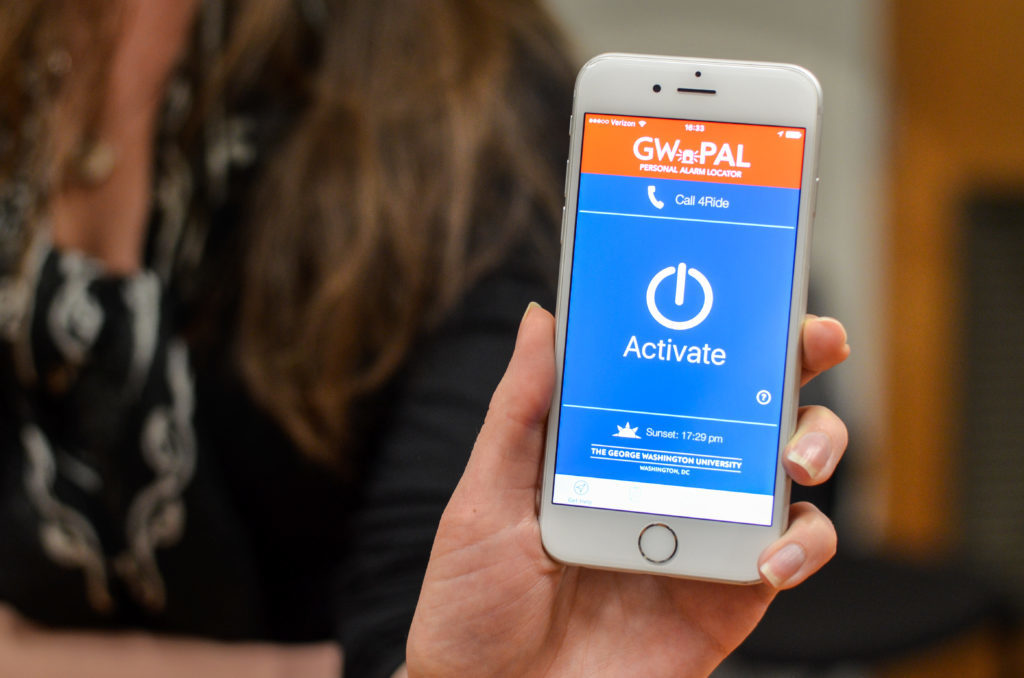Officials have upgraded the University’s security app to make it more efficient for police to locate users in danger, campus security leaders said.
The updated GW PAL app, which will go live this week, will help the University Police Department track users through their phones when they open the app and indicate they need help. Darrell Darnell, the senior associate vice president for safety and security, said his office made the changes to fit students’ and officers’ needs in emergency situations.
Once a user presses the “activate,” button in the app they reach a screen with a map pinpointed at their location. The app does not begin tracking a phone or alerting authorities until the user presses “help,” and after that, a user can add an alert message or call the police. If a call does not come through in 10 to 15 seconds, an officer will call the user, Darnell said.
Before, the app could only pinpoint the location of a student on campus once he or she pressed the button to alert authorities and could not follow the phone as the user moved.
“That way we never lose sight of you,” Darnell said. “We think that’s a significant piece in something that as we go along, we keep trying to make it better.”
The tracking technology cannot identify a specific room where a person is, he added.
GW released the original app created by an alumnus in 2014, which included features like a flashlight and an option to call a taxi. The Division of Safety and Security removed those elements because modern phones traditionally come with flashlights and students use apps like Uber and Lyft for transportation, Darnell said.
Designers added a feature where a user can call 4-RIDE to use as transportation around campus with a goal of making the resource more accessible, Darnell said.
“It’s supposed to be a secure way to get around campus, and ergo if it’s supposed to be a secure way to get around campus it should be easy to get,” he said.
Andie Dowd, former Student Association president, and Casey Syron, former SA executive vice president, proposed creating a 4-RIDE app in 2015 that would operate like Uber and Lyft, in which riders could track the vehicles location and know how long they would have to wait for their rides.
The GW PAL app still includes features for users to submit text or photo tips and an option to include personal information in a profile that would be released to dispatchers if they use the emergency button, he said. UPD does not keep students’ information after the emergency situation ends.
Christina Parker, a project coordinator for the Office of Safety and Security who worked on the app updates, said although the app can only be used on campus, students can submit tips from anywhere.
The Division of Safety and Security worked with the Divsion of IT and student focus groups – including undergraduate, graduate and international students – as it developed the app over the past few months.
Students in Tech Commons, an IT assistance program housed in Gelman Library, were particularly helpful for ensuring the app was tailored to students’ needs, Parker said.
“They were pretty design-oriented, so for them they trust a good-looking app, and they trust an app that looks like it’s been recently updated,” she said.
The students also pitched the idea to add pop-up explanations to each of the buttons that tell users what each button does and start the tracking function, Parker added.
Universities like Florida State University and University of Maryland have launched campus safety apps that both include features to communicate with a user’s specified contacts.
Jocelyn Jacoby, the co-president of Students Against Sexual Assault, said the tracking feature of the app can help people and survivors in particular feel safer, but that people may not immediately think to use the app in the majority of threatening situations.
“To kind of picture people pulling out an app and pressing a button – for the vast majority of stories I’ve heard that doesn’t sound really realistic,” she said.
Aran Mull, the deputy chief of police at the University of Albany, said his university currently does not have a campus security app, but he thinks the continuing tracking feature of GW’s app would help police locate students in dangerous situations.
“We’re not interested in where the initial incident occurred as much as we are interested in finding the person who’s in crisis and helping that person,” he said.





